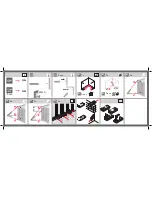
Page 4.6
8-
Setting the diameter: the diameter is the measurement extent corresponding with the
total height of the screen, where the channel is traced.
9-
Setting the location : location of the zero on the screen from -100 to 100% :
o
Max: 100 %: zero is at the top
o
Centre :0 % zero is in the center
o
Min: -100% zero is at the bottom
For example, in the resistance mode, it is interesting to have the zero at its minimum
value (-100%), then we will have the maximum value corresponding to the diameter.
10-
Setting the zero: The zero (or center or offset) is the central value of the measurement.
11-
Summary window and viewing of the threshold, of the diameter, of the offset of the zero
12-
Validation and setting the thresholds of trigger 1 and 2; the outline of thresholds on the
screen is valid in the f (t) mode: a horizontal line allows viewing the threshold.
Note: A warning message displays when the programmed analogic thresholds are out
of the measuring range.
13-
Function: Allows to assign a function of mathematical calculation to the considered
channel.
Without : no function.
Unit change
:
Transforms the measurements unit made on the channel ; you can
program a couple of point X1, Y1 and X2, Y2 to perform a scaling.
Calculation:
available mathematical functions, associated parameters and units.
o
aX+b
is identical to the change of unit but instead of giving a
couple of points, we give the zero (b) and the slope (a).
o
a |X|+b
absolue value
o
a X
2
+bX+c
square
o
a ln(X)+b
Neperian logarithm
o
a Sqrt (dX+c)+b square root
o
aExp(cx)+b
natural exponential
o
a (1/X)+b
opposite.
14-
Channel copy : allows to copy the channel settings on one or several channels.
Summary of Contents for DAS220
Page 7: ......
















































